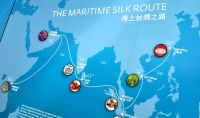Maritime Silk Road
As early as 2,000 years ago, the Maritime Silk Road (海上丝绸之路) started from China's south-east coastal regions, traversing a vast expanse of oceans and seas to countries in Southeast Asia, Africa and Europe.
This trading route that connects the East and the West, had enhanced the exchanges of commodities, people and culture among countries situated on the road.
In order to revive the ancient Maritime Silk Road and bring more benefits to the relevant countries and peoples, Chinese President Xi Jinping proposed in 2013 that China and countries along the ancient Maritime Silk Road would build together a new Maritime Silk Road of the 21st Century.
Such an initiative draws inspiration both from history and from latest developments in the 21st century. The aim is to inject strong impetus in enhancing political mutual trust, deepening economic cooperation, and promoting cultural as well as people-to-people exchanges among relevant countries through joint cooperation, common development and regional integration. All countries along the Maritime Silk Road are welcome to plan, develop and benefit together from the initiative.
Since the initiative was first raised, many countries have actively supported and engaged themselves in the development of the 21st-Century Maritime Silk Road or the Silk Road Economic Belt (the "Belt and Road" for short) or both.
On Oct. 24, 2014, twenty-first Asian countries signed the Memorandum of Understanding on Establishing the Asian Infrastructure Investment Bank (AIIB) in Beijing, aiming to finance and facilitate infrastructure constructions for Asian countries along the "Belt and Road".
The MOU specifies that the authorized capital of AIIB is 100 billion U.S. dollars and the initial subscribed capital is expected to be around 50 billion dollars. The paid-in ratio will be 20 percent.
The 21 countries are Bangladesh, Brunei, Cambodia, China, India, Kazakhstan, Kuwait, Laos, Malaysia, Mongolia, Myanmar, Nepal, Oman, Pakistan, the Philippines, Qatar, Singapore, Sri Lanka, Thailand, Uzbekistan and Vietnam.
At the APEC Summit 2014 held in Beijing in November, 2014, President Xi Jinping announced that China will contribute US$40 billion to set up a Silk Road Fund to provide investment and financial support to carry out infrastructure, resources, industrial and financial cooperation and other projects related to connectivity for countries along the "Belt and Road".
With more support from other countries and wider coverage across the region, the 21st Century Maritime Silk Road has become an initiative not for one country but for all countries who welcome and support the initiative and are working together closely with each other for economic and social advancement as well as for the welfare of their peoples. The 21st Century Maritime Silk Road has always been and will still be open to all countries along the road.
